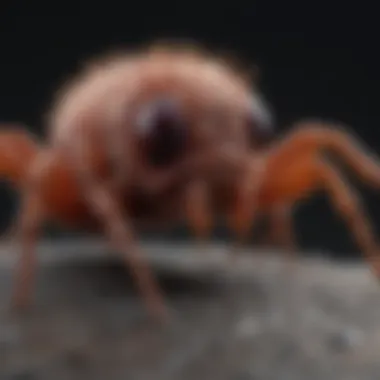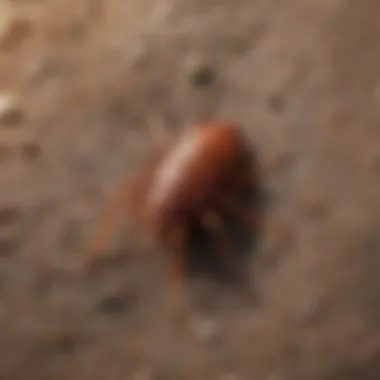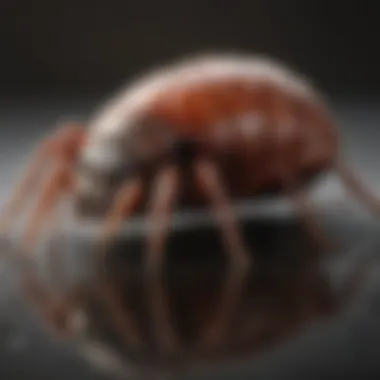Effective Strategies to Eliminate Chiggers in Your Home


Intro
Chiggers, often overlooked, are tiny mites that can cause irritation and discomfort in indoor spaces. Their presence is often underestimated, yet understanding how they operate is key for effective elimination. This guide aims to provide homeowners, particularly housewives and house owners, with practical insights into effectively handling chigger infestations. With a focus on identification, prevention, and treatment, this resource will navigate you through the intricacies of managing these pests in your home.
Pest Identification
Identifying chiggers correctly is crucial for effective control. Misidentifying them can lead to unnecessary treatments and persistent discomfort.
Common Household Pests
While chiggers are one of many household pests, knowing their characteristics can help in distinguishing them from similar creatures. Common household pests that can be confused with chiggers include:
- Fleas: Typically found on pets, fleas leave small bites that cause itching.
- Ticks: Larger than chiggers, they also feed on blood and can transmit diseases.
Chiggers are distinguished by their red or orange coloring, measuring about 1/150 of an inch. They thrive in humid conditions and can penetrate clothing.
Signs of Infestation
Detecting chigger infestations early can dramatically increase the chances of effective eradication. Some key signs to look for include:
- Intense itching: The bites of chiggers cause great discomfort and often lead to scratching.
- Red welts: Look for red, itchy bumps on the skin, often appearing in clusters.
- Presence of mites: You may see tiny red or orange mites in areas where chiggers thrive, such as grass and bushes.
"Effective pest control begins with proper identification and understanding of the life cycle of the pest."
Prevention Methods
Preventing chigger infestations is often easier than dealing with them. Implementing key strategies can create an uninviting environment for chiggers in your home.
Environmental Modifications
Maintaining a chigger-free home requires several environmental modifications:
- Reduce humidity: Chiggers thrive in moist conditions, so dehumidifying your home can help.
- Adjust landscaping: Keep grass trimmed and remove debris where chiggers like to hide.
Home Maintenance Tips
Regular maintenance can significantly reduce the risk of chigger invasions:
- Seal cracks and crevices: Ensure there are no openings in windows and doors.
- Clean regularly: Regular vacuuming and dusting help eliminate potential hiding spots for pests.
DIY Pest Control Solutions
Homeowners can resort to various DIY pest control solutions that focus on both natural remedies and practical traps.
Natural Remedies
Several natural solutions can effectively deter chiggers:
- Diatomaceous earth: Sprinkling this fine powder in areas prone to infestation can deter chiggers.
- Essential oils: Oils like tea tree and lavender repel chiggers when diluted and sprayed in infested areas.
DIY Traps and Barriers
Creating traps or barriers can also be an effective strategy:
- Moisture traps: Placing bowls of water with soap can attract and capture these pests.
- Physical barriers: Using mesh screens on doors and windows can help keep chiggers outside.
Understanding Chiggers
Understanding chiggers is a fundamental aspect of controlling their presence in your home. Knowing the enemy, in this case, the chigger, provides homeowners with valuable insights into effective strategies for prevention and extermination. Chiggers, being microscopic mites, can be easily overlooked, leading to infestations before one realizes the extent of the problem. The discomfort from their bites, which often leads to intense itching, can affect daily routines, causing significant distress.
Furthermore, awareness of chigger biology, behavior, and life cycle equips homeowners to implement targeted approaches that reduce the likelihood of recurring issues. Comprehending where chiggers thrive and how they invade living spaces is key to creating an effective defense. This knowledge empowers individuals to make informed decisions on pest control methods, whether opting for chemical solutions or natural remedies, and to know when to seek professional assistance.
Biology of Chiggers
Chiggers are tiny, red or yellow-orange mites belonging to the Trombiculidae family. They are less than 1/150th of an inch in size, making them nearly invisible to the naked eye. Their biology is fascinating yet concerning. The adult form is not the one causing issues; it’s the larval stage that poses a threat to humans and pets. This stage is when they infest skin, feeding on dermal cells, which leads to the characteristic itch and irritation.
Chiggers possess specialized mouthparts that allow them to pierce the skin and inject digestive enzymes, causing localized inflammation. This reaction is what triggers itching and can last for several days depending on individual sensitivity. Understanding their biological structure and feeding behavior is critical for recognizing why and how they affect your home and family.


Behavioral Patterns
Chiggers are most prevalent in warm, humid conditions. They tend to inhabit grassy areas, gardens, and wooded regions. Their behavioral patterns indicate they often remain close to the ground, waiting for potential hosts to brush against them. Once a host is detected, they latch on and begin feeding quickly.
Moreover, chiggers are not necessarily active at all times. They tend to feed in the early morning or late afternoon, aligning with certain climatic conditions. This pattern of activity underscores the importance of timing in preventive measures. By recognizing these behavioral traits, homeowners can limit their exposure during peak activity hours, thereby minimizing risk.
Life Cycle of Chiggers
The life cycle of chiggers consists of four stages: egg, larva, nymph, and adult. The eggs hatch into larvae after a few days, with larvae being the only stage that feeds on blood. Once they have fed, they fall off the host, developing into nymphs. Nymphs and adults are not parasitic; instead, they feed on plant matter and organic debris. Thus, while the larvae pose the immediate threat, understanding this cycle is critical in identifying when and how infestations can occur.
The typical life cycle can span several weeks, depending on environmental conditions. Recognizing these stages can help in implementing control measures at various points before they reach the larval stage. Understanding the life cycle contributes an additional layer of knowledge for homeowners in their pest management strategies.
Identifying Chigger Infestations
Recognizing chigger infestations is a critical part of managing these pests effectively. Early detection allows homeowners to act promptly, preventing further spread and reducing discomfort associated with chigger bites. Identifying the signs of an infestation leads to the successful implementation of control measures, whether through chemical solutions, natural remedies, or professional services. Knowing where these pests typically enter a home also aids in prevention efforts, while being able to differentiate chiggers from other similar pests ensures the right approach is taken to eliminate them.
Signs of an Infestation
Detecting chigger infestations is not always straightforward. However, there are distinct signs that can indicate their presence:
- Bites on the body: The first noticeable sign of a chigger infestation may be bites on the skin. These bites often lead to itching and irritation, commonly appearing in clusters around areas like waistbands and skin folds.
- Visible movement: In some situations, chiggers may be seen crawling on skin or clothing. They are usually very tiny, but their movements give a clue to their presence.
- Increased scratching: If you or anyone in the household exhibits a sudden need to scratch or appear distressed by itchy skin, it might suggest a chigger problem.
- Presence of red spots or welts: Look out for the small red welts or spots that can develop after being bitten. These are often more pronounced in individuals with sensitive skin.
By recognizing these signs early, residents can promptly mitigate the infestation.
Common Areas of Entry
Chiggers typically find their way into homes through several common routes. Being aware of these pathways can help in preventing infestations:
- Windows and doors: Gaps around windows and doors provide easy access for chiggers trying to enter a home from the outside.
- Moist areas: Chiggers thrive in damp, grassy areas. They can be carried into homes on shoes or pets.
- Unsealed cracks: Any small crack or crevice around the foundation or walls may act as an entry point for chiggers seeking a habitat.
- Luggage and clothing: When returning from outdoor adventures, chiggers can hitch a ride on clothing and personal items, bringing them directly into the living space.
By closing off these entry points, it is possible to significantly reduce the risk of an infestation.
Differentiating Chiggers from Other Pests
Many pests may share similarities with chiggers, making it essential to distinguish them. Here are key differences:
- Size: Chiggers are exceptionally small, about 1/150 of an inch long, making them virtually invisible to the naked eye. In contrast, other common pests, like fleas or ticks, are larger.
- Lifespan of bites: Chigger bites cause intense itching shortly after they occur and can linger, while flea bites often show immediate redness and tend to be more widespread.
- Habitat preference: Chiggers prefer grassy areas; knowing this can help limit confusion with indoor pests, like bed bugs or cockroaches, which are more associated with specific environments.
Knowing these distinctions helps to approach the problem more effectively and reduces the chances of misidentifying the pest, ensuring the right control strategy is followed.
Preventive Measures Against Chiggers
Preventing chigger infestations is crucial for maintaining a comfortable home. These mites can cause intense itching and discomfort, not to mention their potential to disrupt daily life. By implementing preventive measures, homeowners can greatly reduce the risk of an invasion. This section will provide clear and actionable strategies that focus on home maintenance, landscaping, and storage practices. The goal is to help readers create an environment that discourages chiggers from taking hold.
Home Maintenance Tips
Proper maintenance of one's home can significantly diminish the chances of chigger infestations. Regular cleaning habits play a vital role in prevention. Start by vacuuming frequently. Pay extra attention to corners, carpets, and upholstered furniture, as these are common hiding spots for chiggers.
In addition to vacuuming, consider washing linens and clothing regularly in hot water. This is important because chiggers can cling to fabrics, making them part of their domain. Another maintenance tip is to control humidity levels in living spaces. Use dehumidifiers in moist areas, as chiggers thrive in humid environments.
- Seal gaps and cracks in walls, windows, and doors to prevent access.
- Additionally, keep bathrooms and kitchens dry.
Another effective measure includes using insect repellents on shoes and clothing if individuals will be working outdoors. This simple step can limit the chances of bringing chiggers into the home.
Landscaping Considerations
Landscaping plays a significant role in either attracting or repelling pests like chiggers. To prevent these mites from residing near or in your home, it's essential to create a less hospitable environment for them. Here are some key considerations:
- Maintain a well-trimmed lawn to minimize the habitat for chiggers. Long grass and dense vegetation can provide ideal conditions for chiggers to thrive.
- Use gravel or mulch in garden beds. This not only beautifies the yard but also helps deter chiggers by providing a less favorable environment.
- Limit overgrown bushes and shrubs around the house, as these can be hotspots for pests.
Bear in mind that creating spacing between shrubs and ground cover can also help. Chiggers prefer shaded, moist areas, so maximizing sunny spots in your landscaping can work against them.
Storage Recommendations
Proper storage of items around the home can further aid in preventing chigger issues. Chiggers often find their way into homes through items that are not stored correctly. Consider these tips:
- Store clothing and fabric items in sealed containers. This protects them from possible infestations.
- Regularly check storage areas, such as attics or basements, where pests tend to nest.
- Keep outdoor gear clean and stored properly after each use. Items such as gardening tools and outdoor clothing should be kept in designated areas to prevent chiggers from hiding.
By being diligent with storage practices, homeowners can minimize the risk of chigger-related issues.


By focusing on these preventive measures, individuals can take proactive steps to safeguard their homes against chigger infestations.
Methods for Killing Chiggers Inside Your Home
In tackling chigger infestations, it is vital to implement effective methods that target these pests directly in the areas where they thrive. Various strategies exist, each with its own advantages and drawbacks. Prioritizing appropriate methods ensures not only the immediate removal of chiggers from your living space but also contributes to long-term prevention efforts. Choosing the right method is essential because it can significantly influence the effectiveness of your control measures and the comfort of your home environment.
Chemical Pest Control Solutions
Chemical interventions often provide immediate relief from chigger infestations. They can reduce the population quickly, especially in severe cases, making them a favored option among homeowners.
Types of Chemicals
Chemical products are formulated specifically to eliminate pests like chiggers. Common types include pyrethroids, organophosphates, and carbamates.
- Key characteristic: These chemicals target the nervous system of chiggers, causing paralysis and death.
- Beneficial choice: They are widely available and have proven effectiveness against chiggers, making them a popular option.
- Unique feature: Many formulations are designed for indoor use, providing convenience for households.
- Advantages & Disadvantages: While effective, their use raises concerns about toxicity to pets and humans, necessitating careful application and adherence to safety guidelines.
Application Techniques
Proper application of chemical solutions enhances their effectiveness and safety. Techniques such as spraying, fogging, or using mite traps are common.
- Key characteristic: Some methods ensure even distribution across surfaces where chiggers may reside.
- Beneficial choice: Techniques like fogging can reach even the most hidden areas.
- Unique feature: Many products come with guidelines for optimal use, ensuring that the chemicals work effectively while minimizing risks.
- Advantages & Disadvantages: Initial costs can be higher, and careful procedural adherence is needed to avoid overexposure.
Safety Precautions
Safety considerations are crucial when using chemical pest control methods. Proper handling and application of these products protect both residents and pets.
- Key characteristic: Equipment like gloves and masks prevent exposure to harmful substances.
- Beneficial choice: Following safety instructions reduces the risk of adverse effects.
- Unique feature: Many products have specific re-entry intervals, guiding when it is safe to return to treated areas.
- Advantages & Disadvantages: While they are powerful for extermination, misuse can lead to health issues, emphasizing the need for caution.
Natural Remedies for Chigger Elimination
For those who prefer a more natural approach, various remedies exist that may deter chiggers without the use of harsh chemicals. These options might be less effective in severe infestations but can be part of an integrated pest management strategy.
Essential Oils
Essential oils derived from natural sources offer a non-toxic approach to pest control.
- Key characteristic: Oils like peppermint, neem, and tea tree have repellent properties.
- Beneficial choice: Many people find them appealing due to their natural origin and lower toxicity levels.
- Unique feature: These oils often carry pleasant scents, enhancing indoor air quality.
- Advantages & Disadvantages: While effective as natural repellents, they may require frequent reapplication and may not eliminate chiggers permanently.
Vinegar Solutions
Vinegar is versatile and can be used as a cleaning and repellent agent against chiggers.
- Key characteristic: Its acetic acid content disrupts pest biology and can deter chiggers.
- Beneficial choice: Being safe for pets and children makes it a preferable option for families.
- Unique feature: Vinegar solutions are easy to make and use, thus accessible.
- Advantages & Disadvantages: They may not provide the rapid results that chemical solutions offer.
Herbal Preparations
Herbal preparations may also assist in repelling and controlling chigger populations.
- Key characteristic: Many herbs naturally deter pests due to their strong scents.
- Beneficial choice: This approach aligns well with the principles of eco-friendliness and sustainability.
- Unique feature: Homeowners can often grow these herbs, further enhancing their accessibility.
- Advantages & Disadvantages: Effectiveness can vary significantly, and they may require a long-term commitment to see results.
Professional Pest Control Services
Sometimes, enlisting the expertise of professionals is essential. They bring experience and advanced tools to tackle severe infestations more effectively.
Benefits of Professional Help
Engaging with pest control services often means guaranteed results and tailored solutions.
- Key characteristic: Trained experts can identify the extent of the problem accurately.
- Beneficial choice: They use products and methods that may not be available to the general public.
- Unique feature: Professionals can also provide preventative advice for potential future infestations.
- Advantages & Disadvantages: Costs can be a factor, but the investment may save more in damages and health risks down the line.
Choosing a Service Provider
Making an informed choice when selecting a pest control provider maximizes the chance of successful extermination.
- Key characteristic: Credentials and experience matter. Look for licensed and insured services.
- Beneficial choice: Recommendations from friends or online reviews help find reputable options.
- Unique feature: Some providers offer guarantees for their work, ensuring satisfaction.
- Advantages & Disadvantages: Quality can vary among services, so research is essential to avoid poor experiences.
Expected Costs


Understanding the financial implications of professional pest control helps in planning your approach.
- Key characteristic: Costs can depend on the severity of the infestation and the size of the property.
- Beneficial choice: Knowing average prices can help in budgeting effectively.
- Unique feature: Many companies provide free estimates, allowing for informed decision-making.
- Advantages & Disadvantages: Although sometimes expensive, professional services can prove economical when averting extensive damage.
Post-Control Strategies
Post-control strategies are pivotal after initial efforts to rid your home of chiggers. These strategies help ensure long-lasting effectiveness against future infestations. There are several elements to consider when implementing post-control measures that can significantly reduce the chances of chigger reinfestation.
Monitoring for Reinfestation
Once you have addressed the chigger issue, continuous monitoring is essential. Regular inspections of your home will allow for early detection of any chigger return. Pay special attention to areas where chiggers are known to thrive, such as beds, carpets, and upholstered furniture. Additionally, check for signs on outdoor areas close to your home, such as gardens or grassy patches.
To effectively monitor, consider the following steps:
- Routine Cleaning: Keep your home clean. Regular vacuuming and washing of bedding and upholstery can help minimize potential reinfestation.
- Pest Traps: Utilize sticky traps in suspected areas. These can capture chiggers and other pests, giving you an indication of presence.
- Visual Inspections: Look for signs like bites on yourself or pets that could signal an issue.
Long-term Prevention Techniques
Long-term prevention is critical to avoid future problems after the initial treatment. You should implement a comprehensive approach to maintain a chigger-free environment. Here are effective techniques:
- Consistent Yard Maintenance: Keep grass trimmed and remove leaf litter or debris where chiggers tend to hide.
- Garden Practices: Consider planting chigger-repelling plants in your garden. Herbs like lavender can deter these pests.
- Mulch and Wood Chips: Use these sparingly. Too much can create a favorable environment for chiggers.
- Regular Inspections: Make it a habit to check your home and yard regularly to catch any potential issues early.
Evaluating the Effectiveness of Control Measures
After implementing pest control strategies, evaluating their effectiveness is vital. This helps you determine what worked and what might need further adjustment. Here are some methods to assess effectiveness:
- Observation of Symptoms: Track if there are fewer bites or signs of chigger presence post-treatment. A drop in symptoms is a good indicator.
- Frequency of Monitoring Findings: Note any captured chiggers in traps over time. An absence indicates successful control.
- Feedback on Chemical Treatments: If using chemicals, be aware of any lingering smells or residues that might indicate ineffective treatment.
Monitoring, long-term prevention, and evaluation form a continuous cycle. Each step directly influences success in controlling chigger populations.
Chigger Myths and Misconceptions
Understanding chigger myths and misconceptions is central to effectively managing these pests in your home. Misunderstandings can lead to inadequate responses to chigger infestations, prolonging discomfort and increasing risks. It is imperative to clear up these myths to enable homeowners to take appropriate and effective actions.
Common Myths Debunked
- Myth: Chiggers are insects.
Reality: Chiggers are actually mites, which are arachnids. Unlike insects, they have eight legs in their larval stage. - Myth: Chiggers burrow into the skin.
Reality: Chiggers do not burrow. Instead, they attach to the skin and feed on skin cells. The irritation comes from their bite, not a burrowing action. - Myth: Chigger bites transmit diseases.
Reality: While chigger bites can cause significant itching and discomfort, they do not transmit diseases to humans. - Myth: Chiggers only live in the woods.
Reality: Chiggers can be found in many areas, including gardens, grassy lawns, and even in the home environment if conditions are favorable.
These myths often lead to unnecessary panic and ineffective treatment approaches. By recognizing the truth about chiggers, people can better allocate their resources towards prevention and control.
Understanding Chigger Bites
Chigger bites are often mistaken for other types of insect bites. The initial symptoms may resemble those of mosquito bites but can become more severe. After a chigger bites, it injects digestive enzymes that dissolve skin cells. Following this, the body reacts with intense itching and irritation.
The bites typically appear as red, raised spots, often found around the ankles, waist, and in areas of tight clothing. Knowledge about the appearance and reaction to these bites is crucial for accurate identification and appropriate response.
Health Risks Associated with Chiggers
Chiggers are not life-threatening, but their bites can pose a few health concerns. The main health risk arises from scratching the bites, which may lead to secondary infections. Some individuals may also experience allergic reactions to the enzymes injected during the bite.
Here are key considerations regarding health risks:
- Infection Risk: Continuous scratching can open the skin, leading to infection.
- Allergic Reactions: Some may experience heightened reactions requiring medical attention.
- Psychological Effects: The itching can cause significant discomfort, impacting daily life and sleep.
Understanding these risks allows homeowners to take immediate action when chigger bites occur, and minimize discomfort effectively.
Effective management of chiggers involves combination of accurate identification, dispelling myths, and understanding the real nature of health risks.
The End
In summary, the handling of chigger infestations within the home is essential for maintaining both comfort and health. Understanding the dynamics of chigger behavior, an effective response to their presence, and employing preventive measures can lead to a sound domestic environment. This article emphasizes the necessity of addressing chiggers promptly to avoid exacerbated infestations, which can lead to discomfort and unnecessary stress.
Summary of Key Actions
To effectively eliminate chiggers, it is crucial to follow certain key actions:
- Identify Infestations: Regularly inspect your home for signs of chiggers, including skin irritation and bites.
- Engage in Preventive Maintenance: Keep outdoor areas tidy, maintain proper landscaping, and practice consistent indoor cleaning.
- Choose Appropriate Control Measures: Select either chemical or natural methods for combating chiggers based on your comfort level and specific needs.
- Monitor Effectiveness: After applying treatments, keep a close watch for any reoccurrences to take corrective actions quickly.
Future Considerations
As we look forward, it is wise to consider a holistic approach to pest management. This includes:
- Staying Informed: Keep updated on chigger behavior and adaptations in their life cycle to anticipate infestations.
- Sustainable Practices: Consider long-term environmental impacts when applying chemical treatments. Using eco-friendly options is increasingly encouraged.
- Engaging Professionals When Needed: If infestations persist despite best efforts, consultation with a professional pest control service is recommended to address underlying issues.
Ultimately, remaining vigilant and proactive about chigger control will safeguard your living space from these pests.















